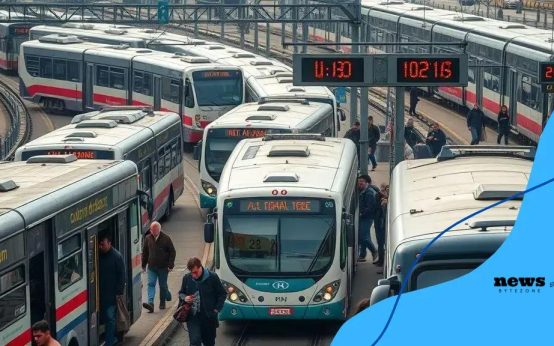Digital access as a public utility mandates that internet connectivity is a basic necessity for all individuals, promoting equitable access to essential services and opportunities for participation in the digital economy.
Digital access as a public utility is an essential concept in today’s world. Have you considered how crucial internet connectivity is for everyone? Let’s dive into why this matters.
Understanding digital access as a public utility
Understanding digital access as a public utility is essential in today’s technology-driven world. It emphasizes the notion that access to the internet is not just a luxury, but a vital service that everyone should have. This concept is gaining traction as more communities recognize the benefits of equitable connectivity.
Why Is Digital Access Important?
Access to the internet provides opportunities that can enhance education, health, and economic development. With reliable online connectivity, individuals can learn new skills, access crucial health information, and connect with job resources. Each of these factors contributes to a better quality of life.
- Increases educational opportunities
- Enhances health communication
- Boosts local economies
Moreover, ensuring that digital access is treated as a public utility helps to narrow the digital divide. This gap currently exists between those who have internet access and those who do not. Communities can foster inclusiveness and growth by reducing this divide. When everyone has an equal chance to connect, society as a whole benefits.
Key Challenges in Providing Access
Despite the growing importance of digital access, there are still significant challenges to overcome. Infrastructure costs, geographical barriers, and policy issues can hinder progress. Local governments and organizations must work together to address these obstacles and create sustainable solutions. One effective approach is to invest in public broadband networks that can serve underserved areas.
- Infrastructure investment is crucial
- Policy adjustments may be necessary
- Community engagement drives change
Ultimately, understanding digital access as a public utility leads to a more informed and empowered society. Ensuring that everyone has the ability to connect will pave the way for innovation and shared learning, benefiting all.
The importance of equitable internet connectivity
The importance of equitable internet connectivity cannot be overstated in our digital age. It ensures that everyone, regardless of their socioeconomic status, has the ability to access vital online resources. When people can connect to the internet, they open the door to countless opportunities.
Benefits of Equitable Connectivity
Having equal access to the internet allows individuals to participate in a wide range of activities. From online education to telehealth services, connectivity plays a vital role in personal and professional development. When everyone has access, communities become stronger and more resilient.
- Improved educational outcomes through online learning
- Greater access to healthcare, especially in remote areas
- Enhanced job opportunities and economic growth
Moreover, equitable internet connectivity helps bridge the digital divide. Many low-income families struggle to afford internet services, which can limit their chances for success. By providing affordable access, we empower these communities to thrive and contribute to society.
Addressing the Digital Divide
To address the lack of access, governments and organizations must focus on developing infrastructure in underserved areas. Public-private partnerships can play a key role in expanding connectivity while reducing costs. Community initiatives, such as providing free Wi-Fi in public spaces, also help to ensure everyone can connect.
- Investing in local internet infrastructure is crucial
- Policy changes may be needed to support access
- Engaging communities to understand their specific needs
Ultimately, the push for equitable internet connectivity is about creating a more inclusive society. It encourages innovation and ensures everyone has a voice in an increasingly digital world.
Challenges in providing universal digital access

Challenges in providing universal digital access are significant and impact many communities. While the need for internet accessibility grows, several barriers still stand in the way. From geographical isolation to lack of infrastructure, these challenges can limit connectivity for millions of people.
Geographical Barriers
In many rural areas, the landscape itself poses a challenge. Mountains, forests, and other natural obstacles can make it difficult for internet service providers to lay the necessary cables or set up towers. This results in a lack of service in remote communities where connectivity is critical.
- Physical terrain limits infrastructure development
- Fewer customers deter investment in remote areas
- Mobile connectivity is often inadequate
Furthermore, even in urban settings, not all neighborhoods receive the same quality of service. Many low-income or underserved areas may have limited options for affordable internet access. This disparity can deepen the digital divide and hinder economic growth.
High Costs and Affordability Issues
The cost of providing internet service can be quite high, especially in underserved areas. Service providers may struggle to find a balance between offering affordable plans and covering their operational expenses. As a result, many families find themselves unable to pay for necessary internet services, affecting their ability to work, learn, and connect.
- High infrastructure costs limit service expansion
- Affordable prices may not attract sustainable business models
- Lack of government subsidies further complicates accessibility
Moreover, policies and regulations may not always support the goal of universal access. In some cases, outdated policies hinder the growth of competition and innovation. This can keep prices high and options limited for consumers.
Addressing these challenges requires collaboration among governments, companies, and community leaders. Innovative solutions, such as community broadband projects or public-private partnerships, can help bridge these gaps. By tackling these barriers head-on, we can move closer to achieving universal digital access for all.
Case studies: cities leading the way
Case studies of cities leading the way in providing digital access highlight practical examples of innovation and success. These cities show that it is possible to create inclusive internet access for all. By implementing creative solutions, they have overcome significant challenges related to connectivity.
San Francisco’s Free Wi-Fi Initiative
San Francisco launched a citywide free Wi-Fi initiative aimed at providing access to everyone, especially in low-income neighborhoods. The city’s goal was to bridge the digital divide by ensuring that all residents can connect to the internet at no cost. This program has allowed students to complete their homework online and residents to access vital services.
- Free service in public spaces like parks and libraries
- Access for low-income households
- Enhancement of community engagement and participation
This initiative has set a model for other cities to follow. By focusing on community needs, San Francisco has made strides in promoting connectivity.
Chattanooga’s Gigabit Internet
Chattanooga, Tennessee, has taken significant steps to establish itself as a leader in high-speed internet access. The city built its own fiber-optic network, offering gigabit internet speeds to residents and businesses. This investment has attracted new companies and boosted the local economy. With incredibly fast internet, many residents enjoy better connectivity for work and education.
- Fastest internet in the U.S. due to city investment
- Attraction of tech companies and startups
- Improved opportunities for remote workers and students
Chattanooga’s example shows how public investment can pay off, transforming a community and enhancing its economic potential.
These cities are setting standards and showcasing how innovation plays a crucial role in achieving universal digital access. Their successes serve as inspiration for others looking to expand internet connectivity and create a more inclusive digital landscape.
Future prospects for digital access initiatives
Future prospects for digital access initiatives are promising as technology continues to evolve. Many cities and organizations are exploring innovative solutions to ensure that internet connectivity becomes a basic right. As awareness grows about the importance of digital access, new strategies emerge to address previous challenges.
Investment in Infrastructure
One of the key areas for future improvements is in infrastructure development. Governments and private companies are starting to invest more in creating robust networks that provide reliable access to all. This includes upgrading existing connections and expanding services to underserved regions.
- Fiber-optic networks are becoming more common
- Investment in satellite technology enhances rural connectivity
- Community-based networks are gaining traction
As these investments grow, more people will benefit from high-speed internet, enabling them to participate in the digital economy.
Policy Changes and Regulations
Changes in policy can significantly impact future digital access. Many advocates are pushing for regulations that require internet service providers to offer affordable options. Government support in the form of subsidies can help low-income households gain access to necessary services.
- Policies promoting competition can lower prices
- Funding for community projects can expand reach
- Standards for service quality can ensure reliability
Such measures can level the playing field, making digital access more equitable. As the public becomes increasingly aware of the need for accessible internet, they will push for these changes.
The growth of new technologies, such as 5G and advanced wireless networks, holds great potential for the future of digital access. These technologies can provide faster speeds and more reliable connections, especially in areas where traditional infrastructure is limited. With proper implementation, these innovations could reshape how people interact with the internet.
As we look ahead, it’s clear that the focus on providing universal digital access is gaining momentum. With a collective effort from communities, governments, and organizations, the dream of connectivity for all may soon become a reality.
FAQ – Frequently Asked Questions about Digital Access as a Public Utility
What is digital access as a public utility?
Digital access as a public utility means that internet connectivity is considered a basic service for all, similar to electricity or water.
Why is equitable internet connectivity important?
Equitable internet connectivity ensures that everyone has access to the internet, which is crucial for education, job opportunities, and participation in the digital economy.
What are some examples of cities improving digital access?
Cities like San Francisco and Chattanooga have implemented successful initiatives, such as free public Wi-Fi and citywide gigabit internet, to enhance connectivity.
What challenges exist in providing universal digital access?
Challenges include geographical barriers, high infrastructure costs, and ensuring affordable pricing for low-income households.

 PublicTransportAid: Enhance Your Commute Experience Today
PublicTransportAid: Enhance Your Commute Experience Today  Maximize Your Savings: Navigating the Healthcare Benefits Enrollment Period
Maximize Your Savings: Navigating the Healthcare Benefits Enrollment Period  Maximize Your Savings: Navigating the New Healthcare Enrollment
Maximize Your Savings: Navigating the New Healthcare Enrollment